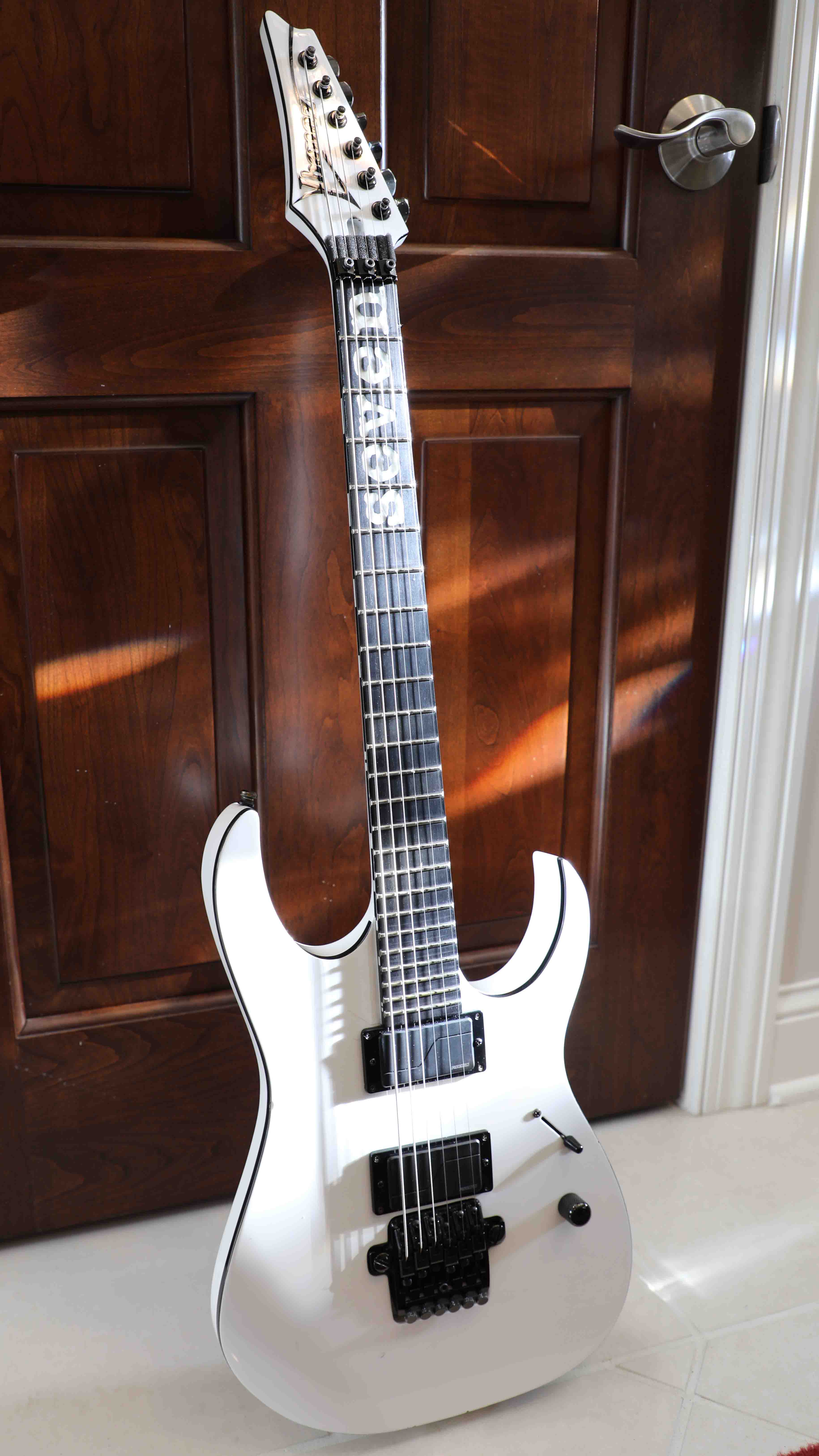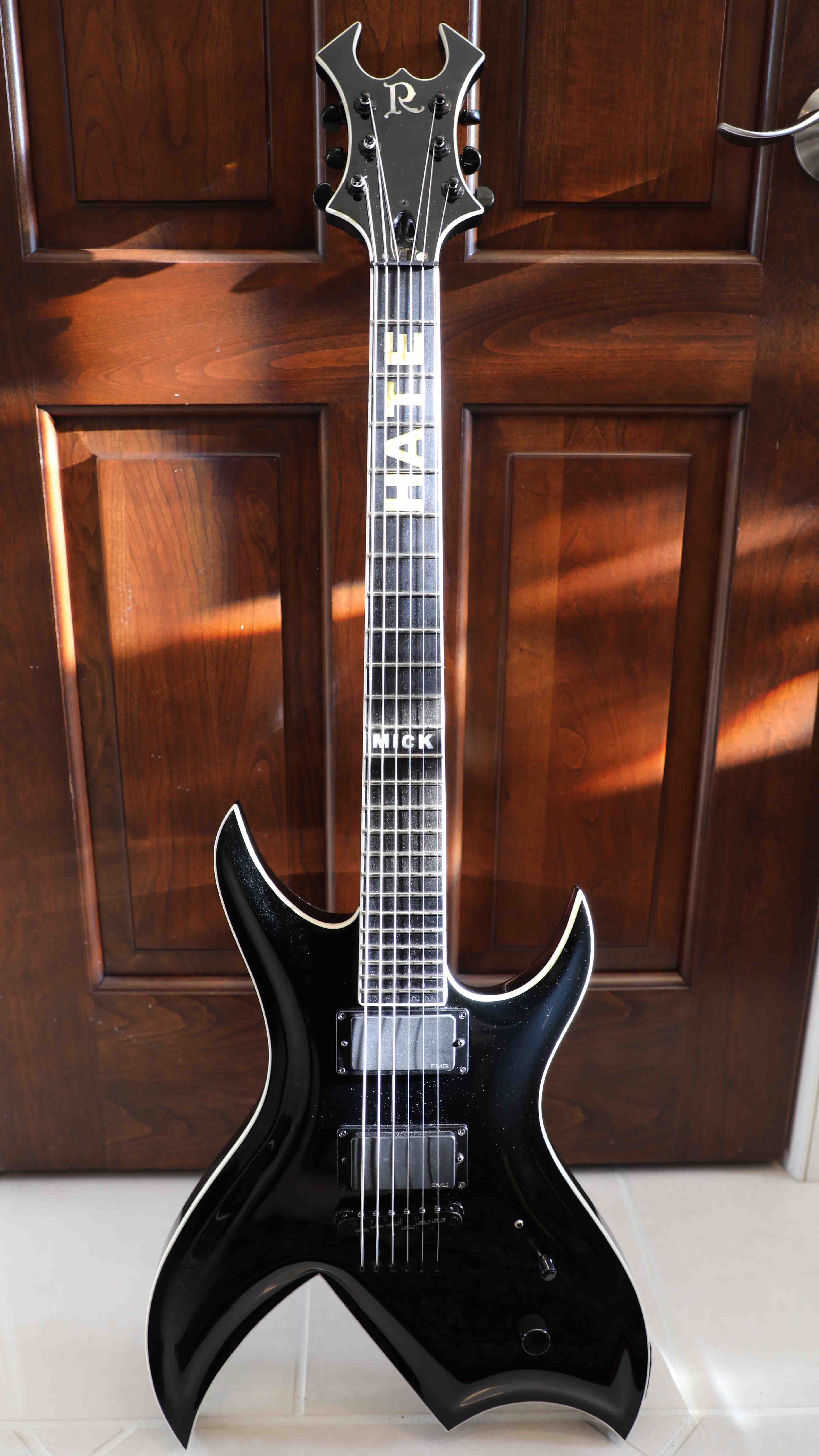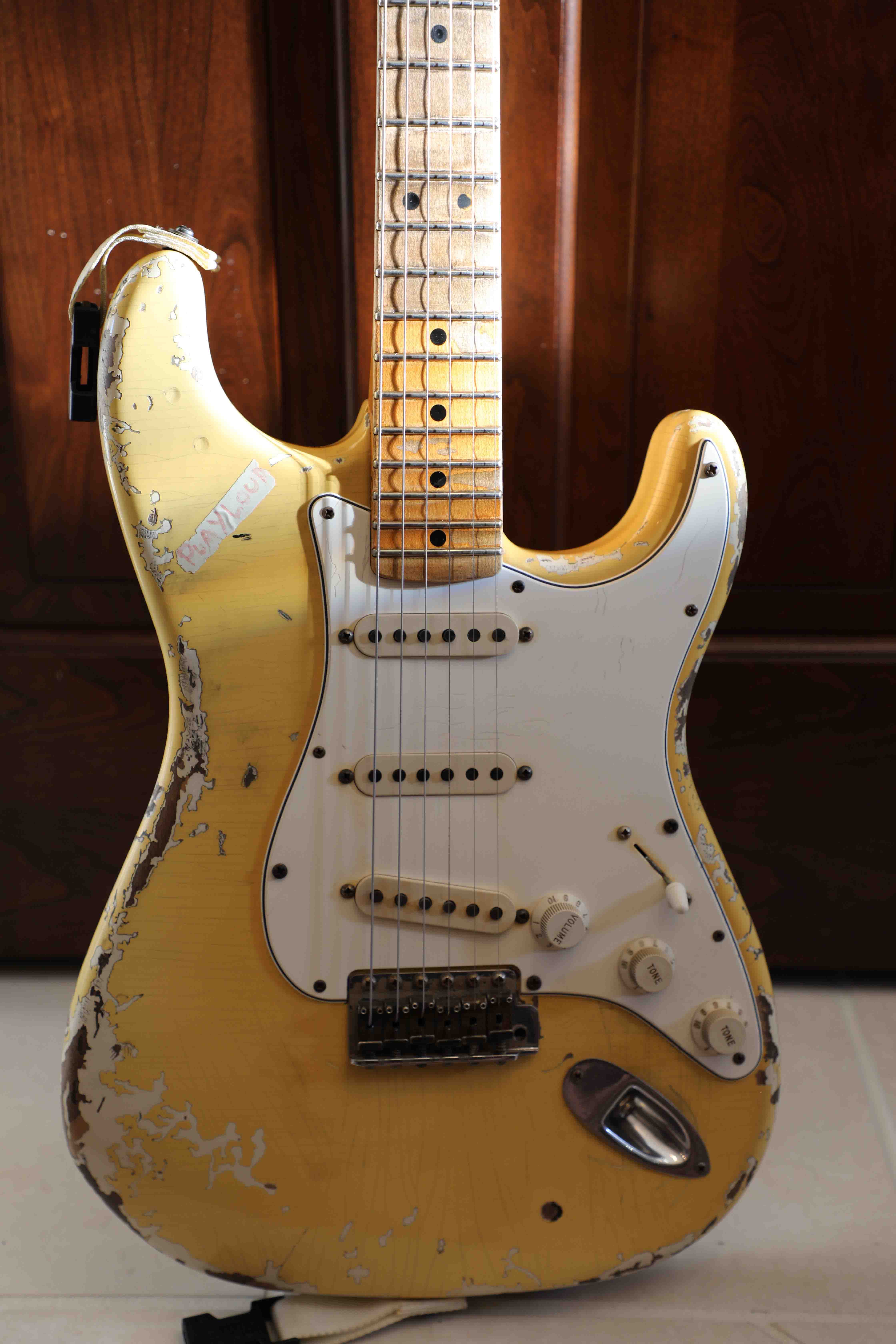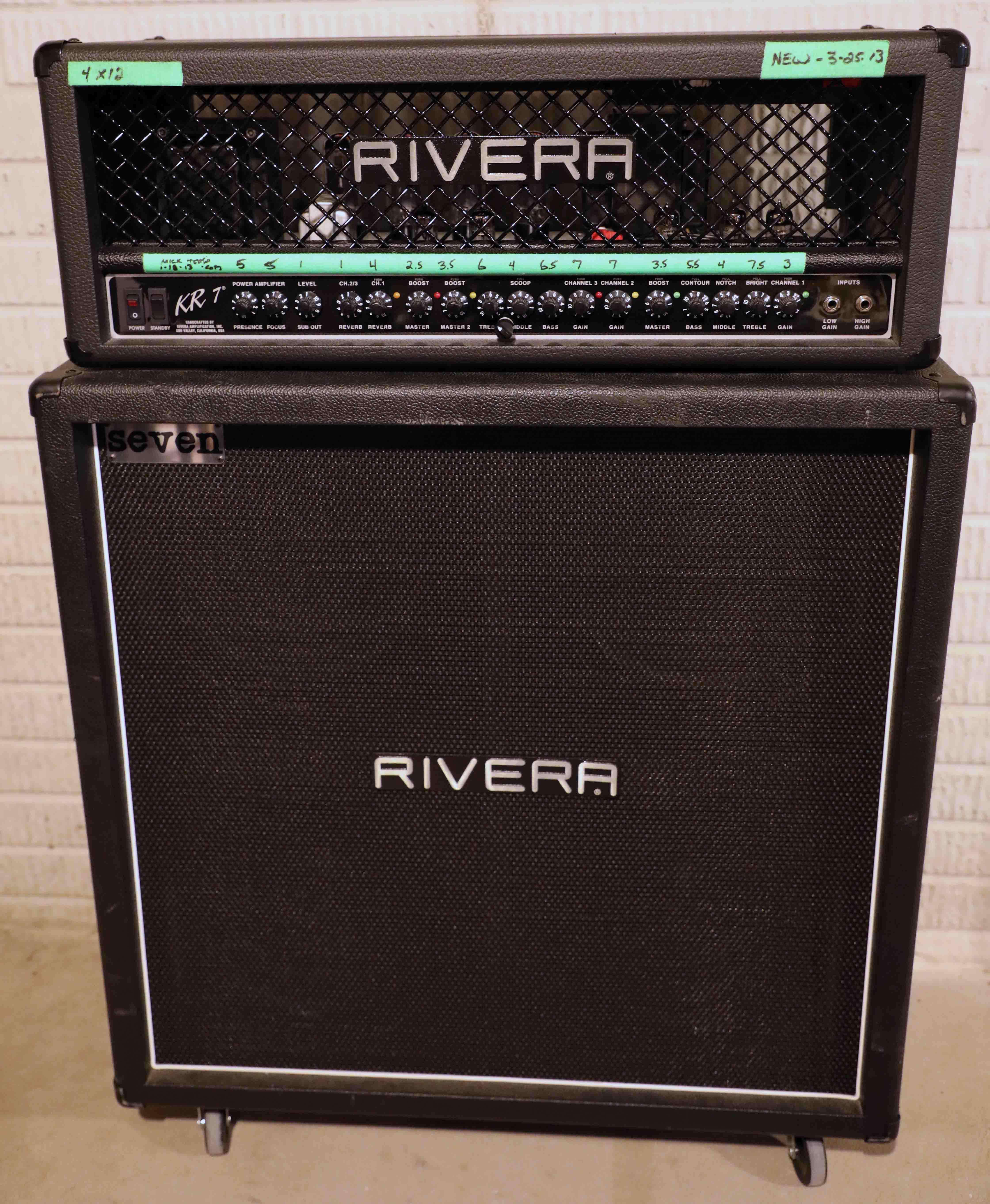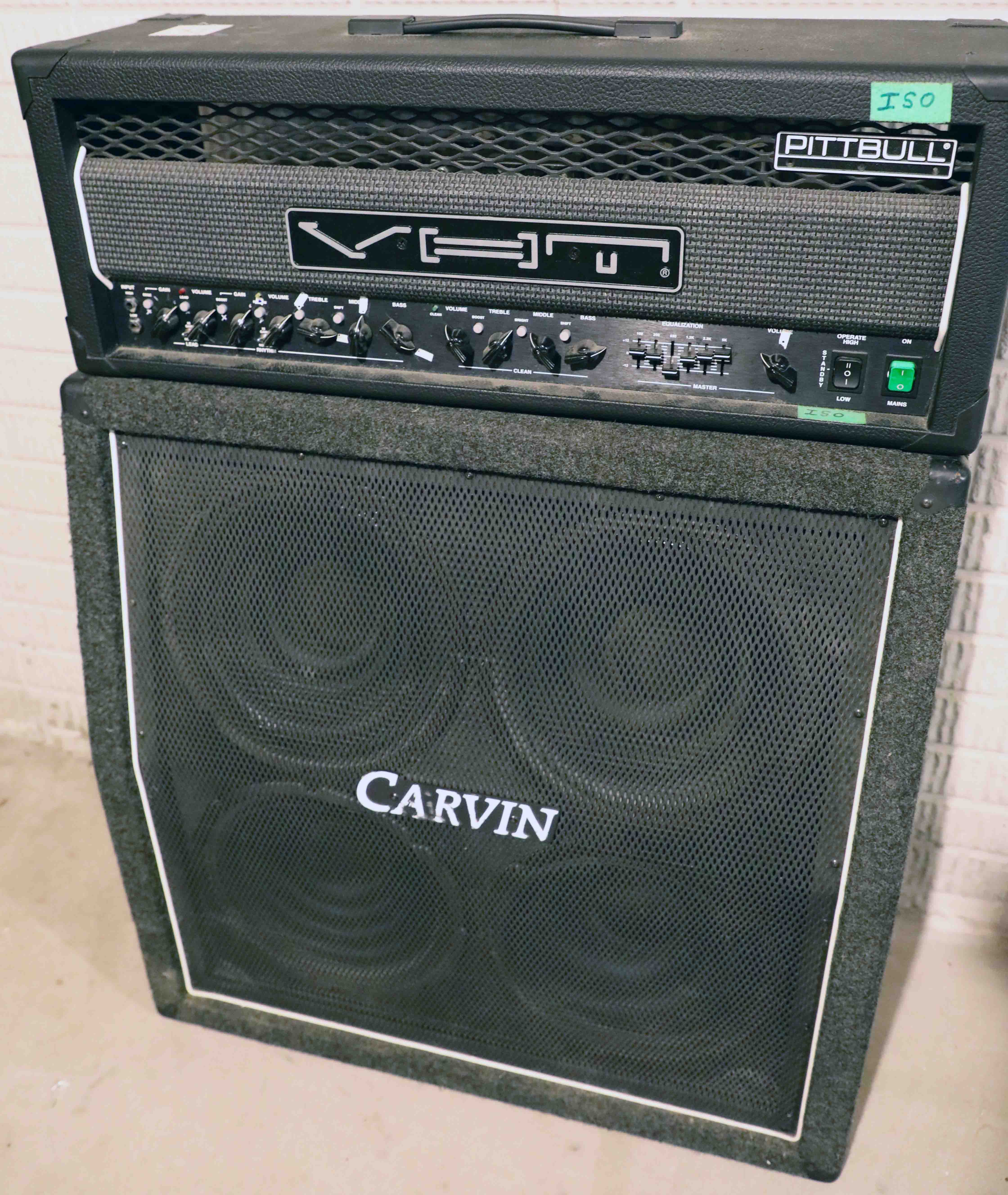In pictures: Slipknot’s Mick Thomson shares his favourite guitars and gear from an extensive collection
In-depth with legendary amps, rare prototypes and much, much more...
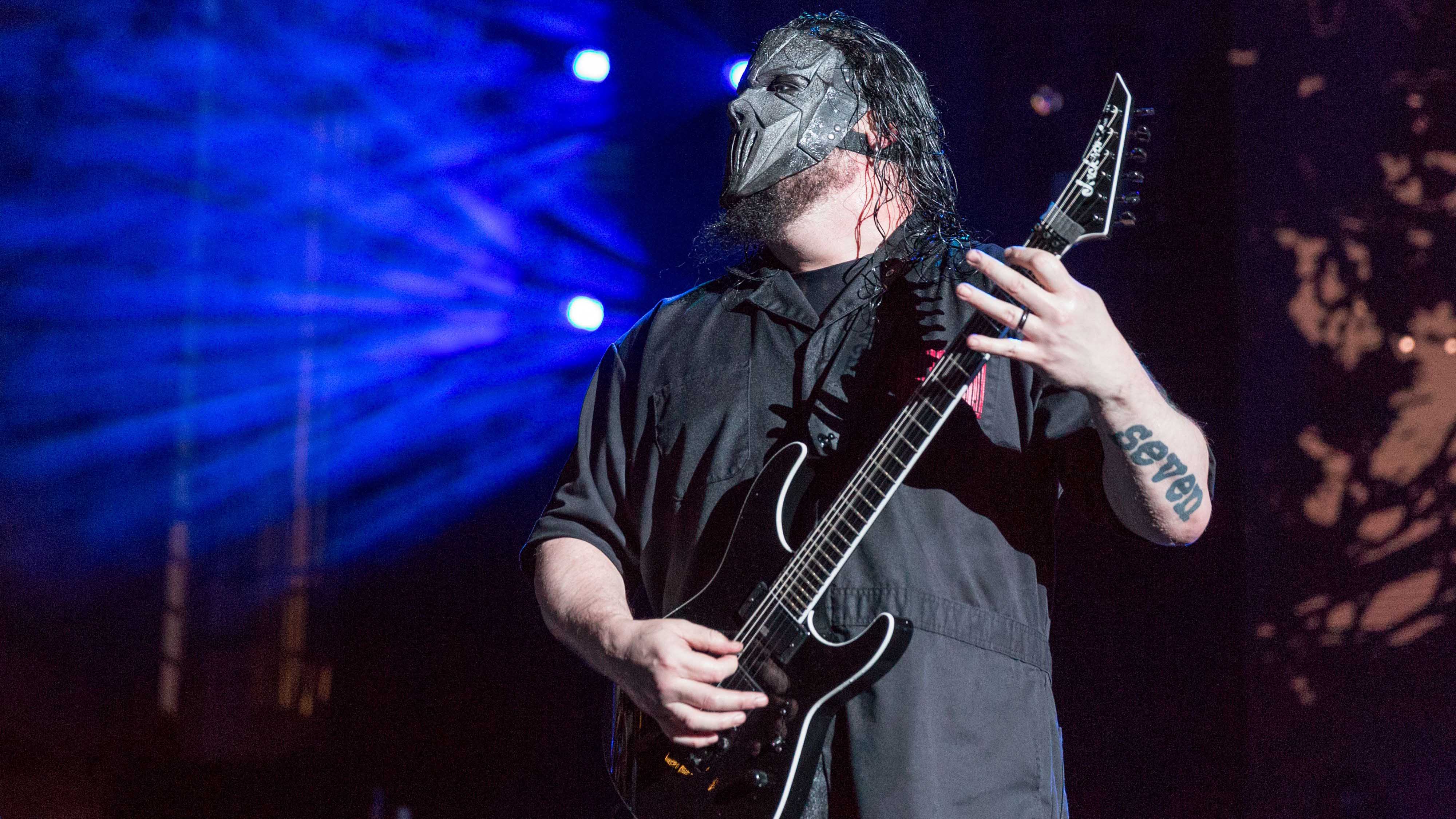
On November 6 2016, Slipknot played their final show of the Gray Chapter cycle - headlining a second night of Knotfest Japan.
With members admitting it will be a bit of a wait until we see them dominate world stages again, fans will have to get their fix from new concert movie Day Of The Gusano.
Filmed around their first-ever show on Mexican soil, taking us into the very eye of the storm, and directed by percussionist M. Shawn Crahan, the multi-format release will be hitting shelves later this month.
So with a bit more time on his hands, in this world-exclusive interview with MusicRadar, guitarist and third-longest serving member Mick Thomson invites us into his world, talking us through the key elements of his rig over the years and the prize pieces of his gear collection…
Day Of The Gusano is out on 20 October, and available to preorder now.
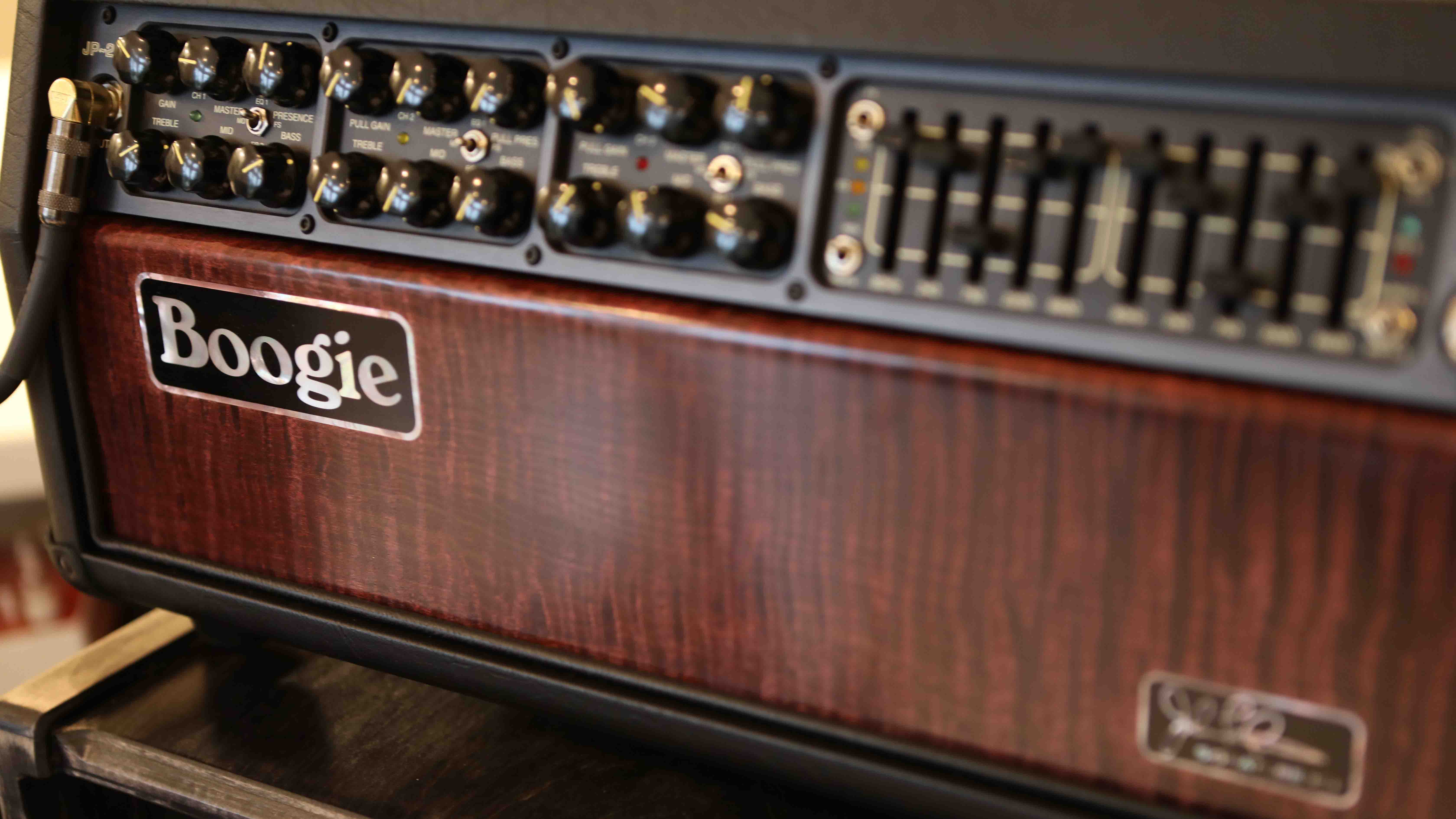
1. Mesa/Boogie JP-2C Limited Edition Mark IIC+ John Petrucci
“This is the new Petrucci signature head that’s based on the Mark IIC+ - which had that classic Dream Theater and early Metallica sound. It’s probably the best amp I’ve ever played and I’ve been using it over the last year of touring on the Gray Chapter cycle.
“We’ve actually been able to play with Dream Theater at European festivals a few times over the years, but I don’t really get to see them. It’ll be for a minute or two in Spain or somewhere! Seeing Images And Words in its entirety would be a religious experience… I have to catch that tour.
“I was listening to Metallica’s Garage Days back when I was in junior high. I always loved the guitar sound, because it sounded so raw, you know? It was real, not ultra-compressed… plus the band were playing kickass. I would listen to it on my home stereo so loud it could rattle the teeth in your head, and I’d just go wild. The start of Breadfan… god damn I wish I had that kinda tone.
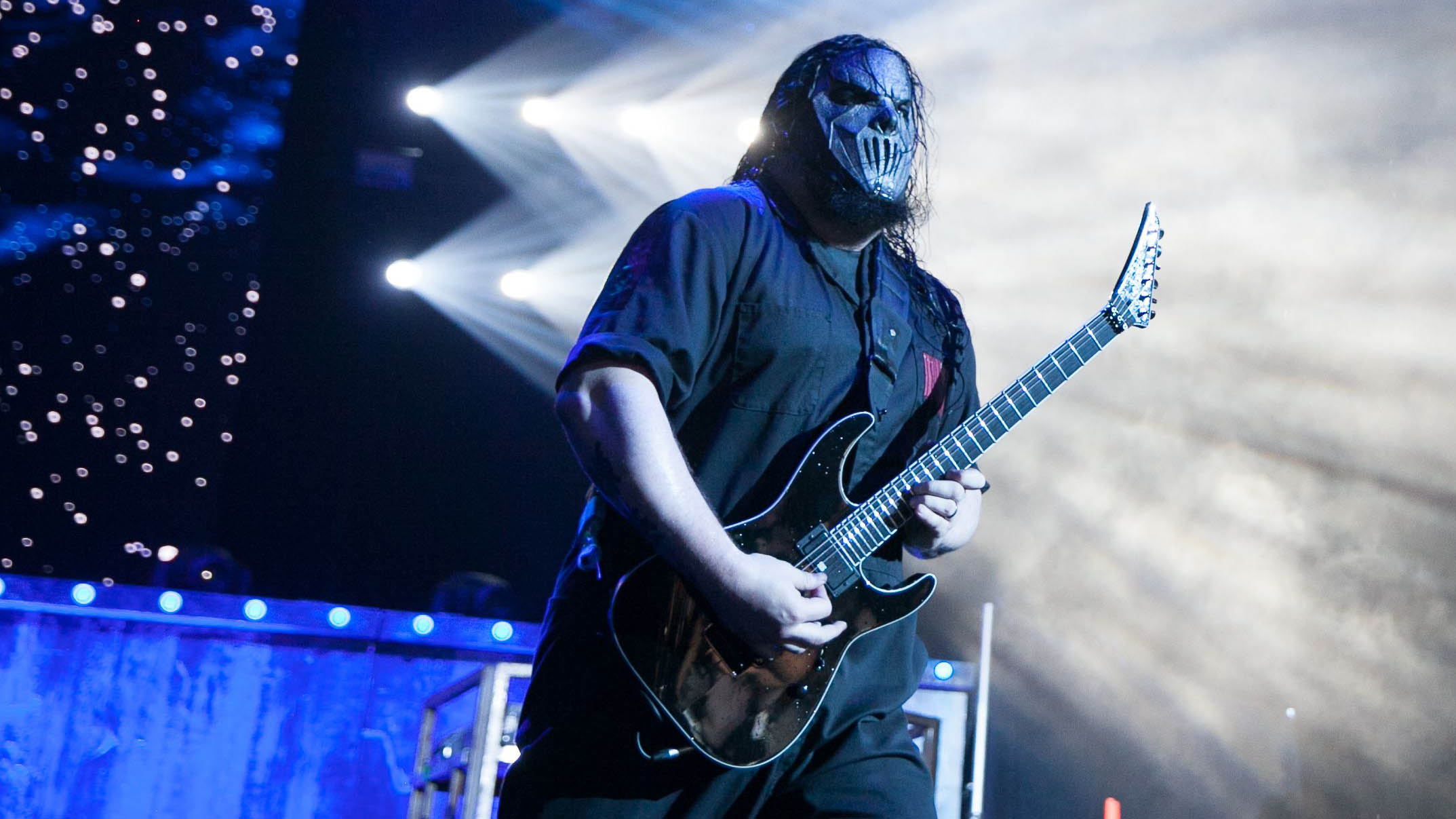
“I was wondering what the fuck they were using, because it wasn’t Marshalls early on. I jumped down that rabbithole and found out it was a Mark IIC+ running into a Marshall power amp, because the C+s were wired in triode and didn’t have the balls. But the preamp sounded amazing, so they ran it like that from everything I’ve read.
“Most of it will probably be horseshit, because I read stuff about me and it’s like, ‘That’s not right, that’s not right, that’s not right and I don’t know where the fuck they got that!’ The internet will be like that for all time, I think: misconception and misinformation will rule the day!
“I was searching for the sound and looked for older C+s to see what I could find. I talked to some of our people and they asked if I had played a Boogie Mark V and I hadn’t.
“I don’t really head into guitar shops much. When I was younger, you couldn’t really buy them - you had to go to Chicago to check them out which was a five-hour drive each way! So I never really had much access to them, other than some old 50 Calibers.
That EQ is one of the greatest things that’s ever happened in music, at least for guitar players!
“I wasn’t really into the whole Rectifier thing - where everyone and their brother wouldn’t know shit about gear, they’d just plug in a Recto and that’s their sound. I didn’t really like that sound, so I never pursued Boogie. Then I learned some of my favourite tones had come from a Boogie; the cleans are just amazing on pretty much any amp I’ve plugged into.
“This amp wasn’t even announced when I started talking to them about it. I was using Mark Vs and I was impressed - that EQ is one of the greatest things that’s ever happened in music, at least for guitar players! I even bought their EQ pedals so I could fix the sound of other amps I didn’t like… suddenly everything would sound great. Right before NAMM, they told me about this new signature, basically a Mark IIC+ with MIDI switching and two of those EQ controllers. I was like, ‘Dude!’ and they sent me one.
“Petrucci’s rig is probably very complicated, with different routings for different effects. So having the MIDI switching system is a perfect solution in one unit, and you can get so many sounds out of it from that super-juicy early-mid Metallica and Dream Theater tones in one box. It’s outstanding.
“Despite the fact I have my own signature amp, I’ve just started using this one. I’ll still plug in my Riveras on different stuff - they’re great amps in their own right - but I’ve never been so impressed by one amp.
“I actually have one of the signature ones with John and Randall from Boogie’s signatures by the serial number - a little card with a plaque on the inside. I have the standard ones, too, but this one’s my baby and will always stay with me at home.”
“This is set up more like Petrucci, but my live rig is a bit different - some of pedals need to run through a clean channel for that digital distortion, which means I need to set my cleans a certain way. Like the tapped part on Surfacing with pitch-shifter and auto-wah: that’s digital distortion coming from a Boss rackmount unit. Spit It Out is the same.”

2. 1998 Jackson Custom Shop Seven-String
“I got this around 2002, but I haven’t used it on any tracks yet. It’s not even a quilt top; it’s 100% quilted maple for the body. It’s a Custom with an Ibanez tremolo and bridge, because no-one else made a seven-string whammy at the time.
I play it at home - because actually most of the time I’m not using a drop-tuned guitar. If I’m sat dicking around, I just like to play in standard tuning
“My friend owns Drum City Guitarland in the Denver area, and he has all this oddball stuff where he’s filled out order forms for all sorts of cool stuff. He had ordered a replacement bridge from Ibanez like it was a repair, and as soon as he got it, he sent it over to Jackson because they didn’t have any. He told me if it wasn’t the first seven-string like that, it was one of them. I’m still trying to find out exactly which - I’ve had a guy at Jackson looking into orders from 20 years ago. They can’t necessarily verify it yet.
“I play it at home - because actually most of the time I’m not using a drop-tuned guitar. If I’m sat dicking around, I just like to play in standard tuning. When you’re writing you’ll play different because the strings aren’t dropped.
“To me, it’s just another tool to get creative with. When you write riffs in drop B or drop A, you end up repeating yourself. It’s so hard to mentally break out and do something different. At least with a seven-string you can still play it like you would a normal guitar.
“Earlier on, I didn’t really like them because people kept coming at me because it was cool to have a seven-string, yet most players would only chug on the lower string. Why have a massive neck for your little hands? Why play seven strings when you haven’t learned how to play six? You have to walk before you can run, dude! Obviously, Steve Vai could play anything and sound great, but most of these guys were nothing like him… so back to the E major chord!
“I kept getting questions about tuning down instead of using a seven-string. I used to say, ‘So what - it has all the notes I need!’ It was a trend at the time; a lot of people were doing it. Plus this guitar is fucking astounding - it sounds and plays incredible.
“I’ve kept it in the case, still with the hangtag on the tuning pegs along with the build spec - like who did the electronics, fret dressing and final inspection. I’ve barely played it, but dug it out a couple of months ago and it was really cool to write with - almost like grabbing a bass, because when you do that, you’ll write riffs so different to what you would with a normal guitar. I tend to approach things with a more rhythmic standpoint and come up with weird groove riffs.”
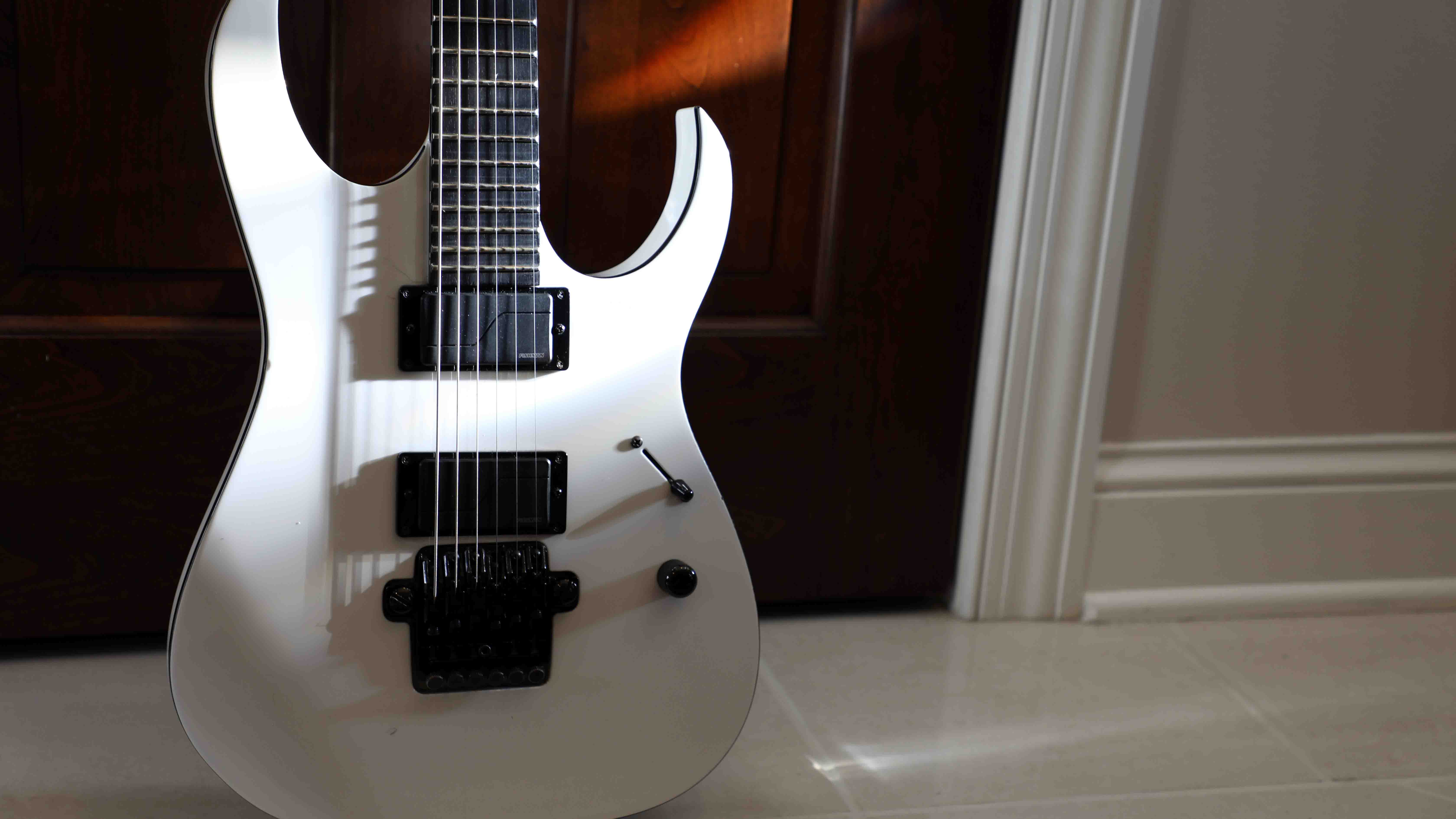
3. Ibanez MTM Stormtrooper
“This is my Stormtrooper guitar that I tracked all of .5… with; I got it around 2005. When Ibanez send you a custom guitar, they send you the date it was completed on. The moment I got it, this thing immediately became my favourite guitar.
“Guitars are made of wood; it doesn’t matter if there’s an ebony fingerboard, eastern hard-rock maple neck-throughs or three-piece babinga or sometimes rosewood. There’s a three-piece laminate neck and then mahogany sides. Every bit of those trees will be different to any other tree - they will all sound unique. You can have 20 guitars of the same spec and they’ll all sound different. This one just sounds magical - it’s big but not too boomy. It’s tight but still really open.
“A lot of guitars sound great when you’re playing through a loud cabinet or whatever, or with the band where there’s all the reflection in the room and the cymbals are eating your ears up - but when you get in the studio, with microphones right up on that cabinet, it’s under a microscope. Guitars that sound great can suddenly become a bit, ‘Meh, not so much!’ This motherfucker sounds absolutely perfect for what I’m doing.
“I got it just after Vol. 3, so it didn’t end up on that, but All Hope Is Gone got tracked with it along with a lot of the rhythms on the latest record, especially songs in B. The songs in A I played those giant pointy-glazed guitars that are 50 pounds of mahogany. They’re a chore to play live, but sound so good in the studio and the sustain is ridiculous. They’re great for songs in A because they have so much resonance.
“Currently the white has different pickups in it: they’re Fishman Fluences which got sent over about a year ago. My tech threw them in just to experiment and I thought they sounded really good in that guitar. You can never have too many sounds!”
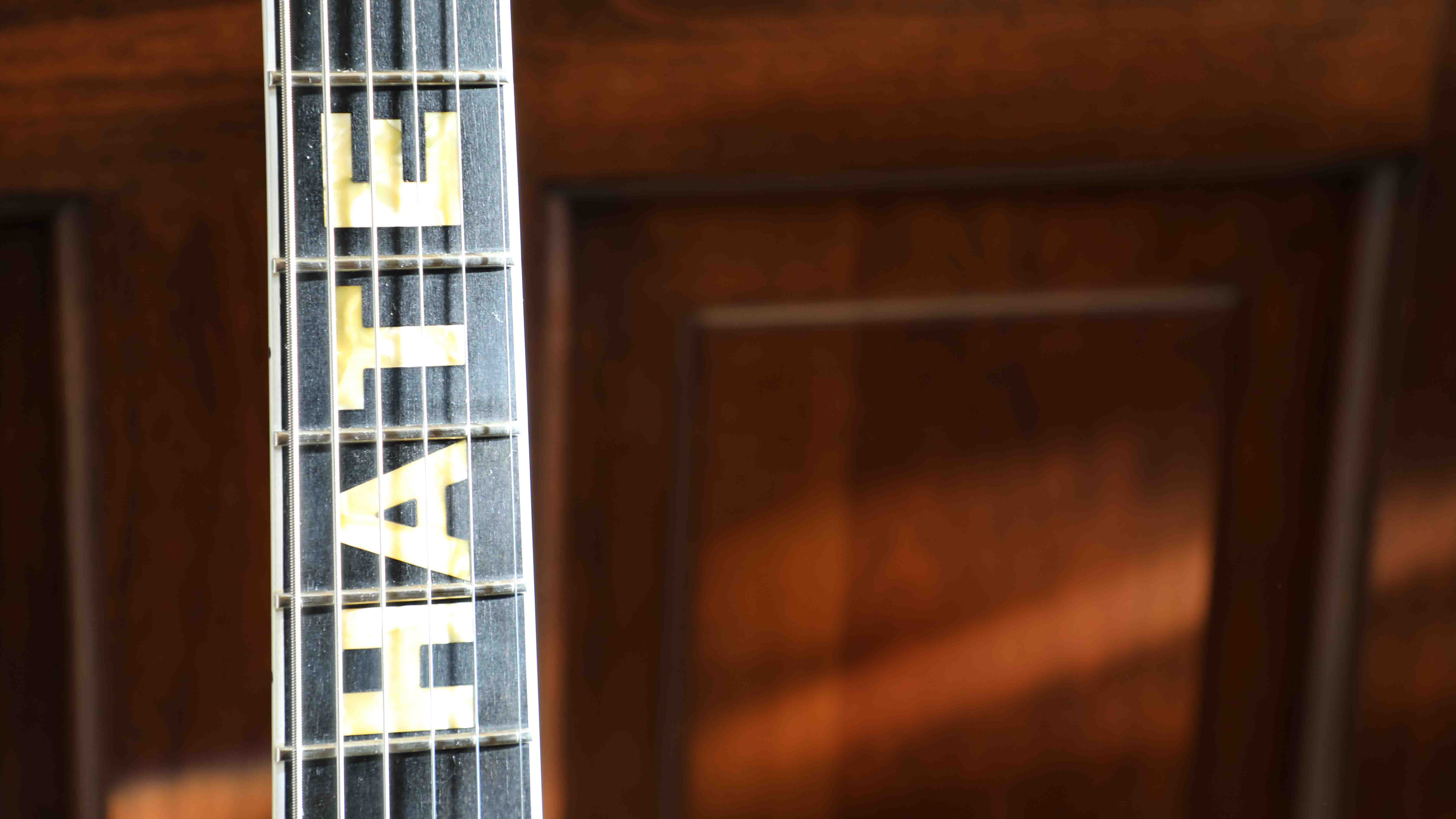
4. B.C. Rich Bich
“I think this was the last B.C. Rich I used live. It was going to be a signature model but I left for Ibanez and they went on to sell it as their own guitar model. B.C. Rich went through a bunch of tumultuous shit within the company after Bernie Sr. died in 1999. My first three guitars were made while he was still there and then that happened.
“I don’t know, maybe it took a bit of steam out of the company because everyone was in shock. Then Bernie Jr. took it over and different things were happening. Some other companies were looking after a lot of the stuff, while the B.C. Rich were handling the handmade Custom USAs.
“I think this model was made in Indiana, Ohio or somewhere by a company that wasn’t them. It just wasn’t the same. This guitar was a fuck-up - it was supposed to be long-scale because I drop-tune and pick fast, so I need more response. This ended up being a short-scale… oopsy! Little bit of an oversight there. It was actually a future model; I’ve got loads of prototypes in cases.
“I wanted a Kahler Pro on it, just for something different - why have 10 of the same fuckin’ guitar, right? It’s a neck-through body, so once you build it, the thing is built. They had it set for a Floyd Rose where the neck is really flat to the body… there was nothing we could do about it. It was a bit like, ‘Are you fuckin’ kidding me? Who is in charge of all this?’
“Bernie Jr. went on to make his own company, in a similar vein to B.C. Rich; I own a couple and they’re awesome-sounding guitars. But on this, there are no string ferrules to guide the strings; they literally terminate in the wood. So every time you tighten the string, it sinks deeper and cuts in! When you take the strings off, you have to yank them backwards to get them free from the body. Who thought of this?!
“The guitar sounds amazing, plays amazing, I fuckin’ love it but it’s just one of those things. There was a bunch of errors and the one that came after it was comically bad.
“So, it just wasn’t what I needed. Interestingly, Joey [Jordison, ex-Slipknot drummer] went on to end up playing B.C. Rich and said all the customs they made for him were awesome, so I hope they got their shit together because they’re a legendary company. It’s good for the guitar to have all these companies making great shit, it’s good for the players. All the guys there were so fuckin’ cool, but it kinda crumbled… I wish them the best and it sounds like they pulled it back together.”
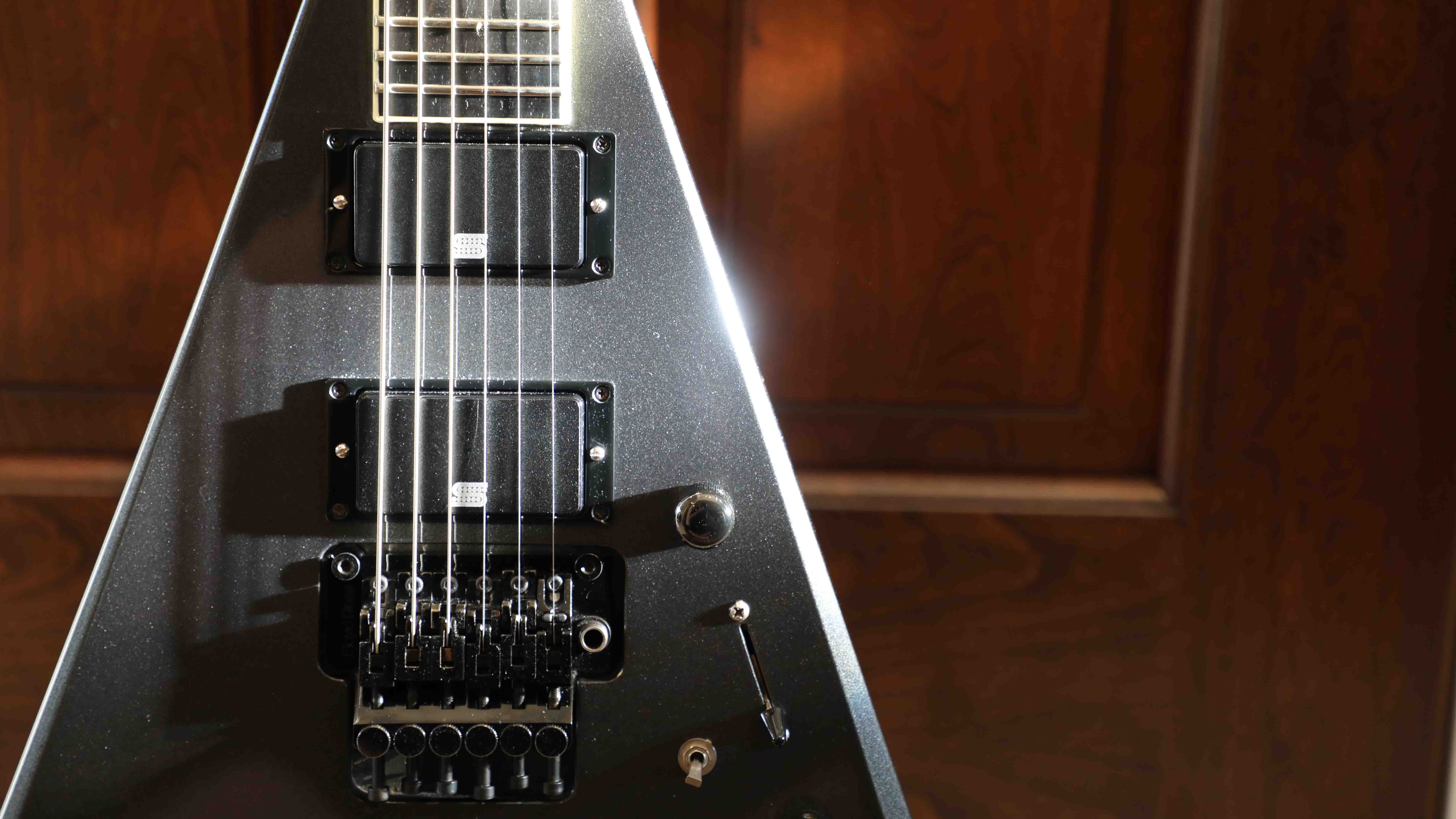
5. Jackson Custom V
“This is one of my originals. It was custom spec’d and built in the early ’90s - I actually wrote and tracked the first record with it. At the time, they didn’t have a Jackson with 24 frets and a Floyd; they only did 24-fret hardtails. So I had to order a custom, and that colour was just perfect. It looks good in photos, but in person it’s even better.
I used it for the first record and all the writing leading up to it… I’d taken out a three-year loan just to have the f**kin’ thing made
“The neck is what makes it extra special - it’s almost as fast as those original Wizards in feel but sounds thicker and better. It’s a Randy Rhoads kinda neck, I guess, from ’87 or ’88; they changed the neck to make them thinner. In order to have enough thickness in the wood to fit the double-expanding trussrod, they had to weld into a channel in the fingerboard to accommodate. This was one of those… I didn’t know it was an oddball neck, they only did it for a couple of years, but it was like their shredder neck.
“And everything about it is perfect: there’s a compound radius so the chords sounds great when you’re down below and it flattens things up high. Jackson are now famous for these necks. My new guitar is a copy of this neck. Jackson took all the measurements and analysed all the shit, so it’s like my black double Rhoads…
“I used it for the first record and all the writing leading up to it. We didn’t have roadcases or anything, and I’d taken out a three-year loan just to have the fuckin’ thing made. It was my baby; I couldn’t have it stolen or damaged. Honestly, I think if I could only keep one, it might have to be this.”
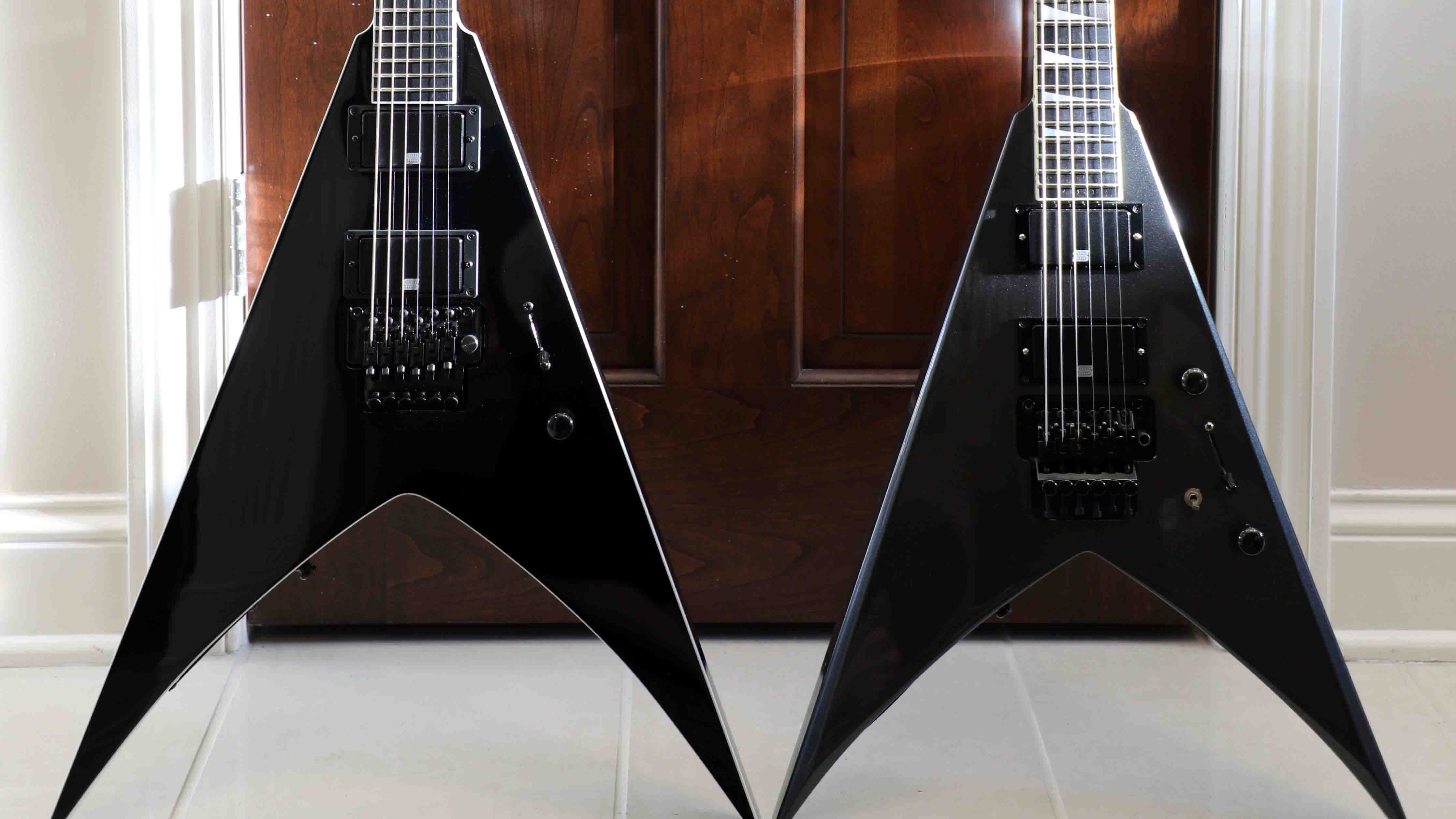
6. Jackson Custom V
“The Black V is the first guitar made for me by Jackson, built by master builder Mike Shannon, who made Randy Rhoads' original white V, the Concorde. He’s a god-tier builder and I’m in awe of the craftsmanship - they nailed the neck so perfectly with this one.
“Everything about it is incredible: you can see the difference in the picture of both of this and the previous V together. It is a really big guitar, about 19 inches from tip to tip on the V. The double Rhoads take the top V of a Randy and mirrors it, so it’s literally twice.
“It has sustain for days and sounds incredible. One thing people probably don’t know is that before this was made, I always used fixed bridges. Even for my Floyd-equipped gun metallic grey, I actually got that blocked off. I don’t need the whammy, and if I break a string… whatever. I can be heavy-handed with my picking, but on this, nothing goes out of tune. There’s no warble and it doesn’t flatten other strings when I bend a different one. It’s crude, but it works!
“I used to teach at guitar shop back then, where they had all these different kinds of wood. I would sand down pieces and tap them in on both sides of the block so I’d get the neck through back. The energy coming through the guitar didn’t have to go around a big fuckin’ hole in the middle. With this new V, Jackson found a way to take an original Floyd and put in a sustain block. There are no springs in the back, it doesn’t whammy, it’s a fixed bridge.
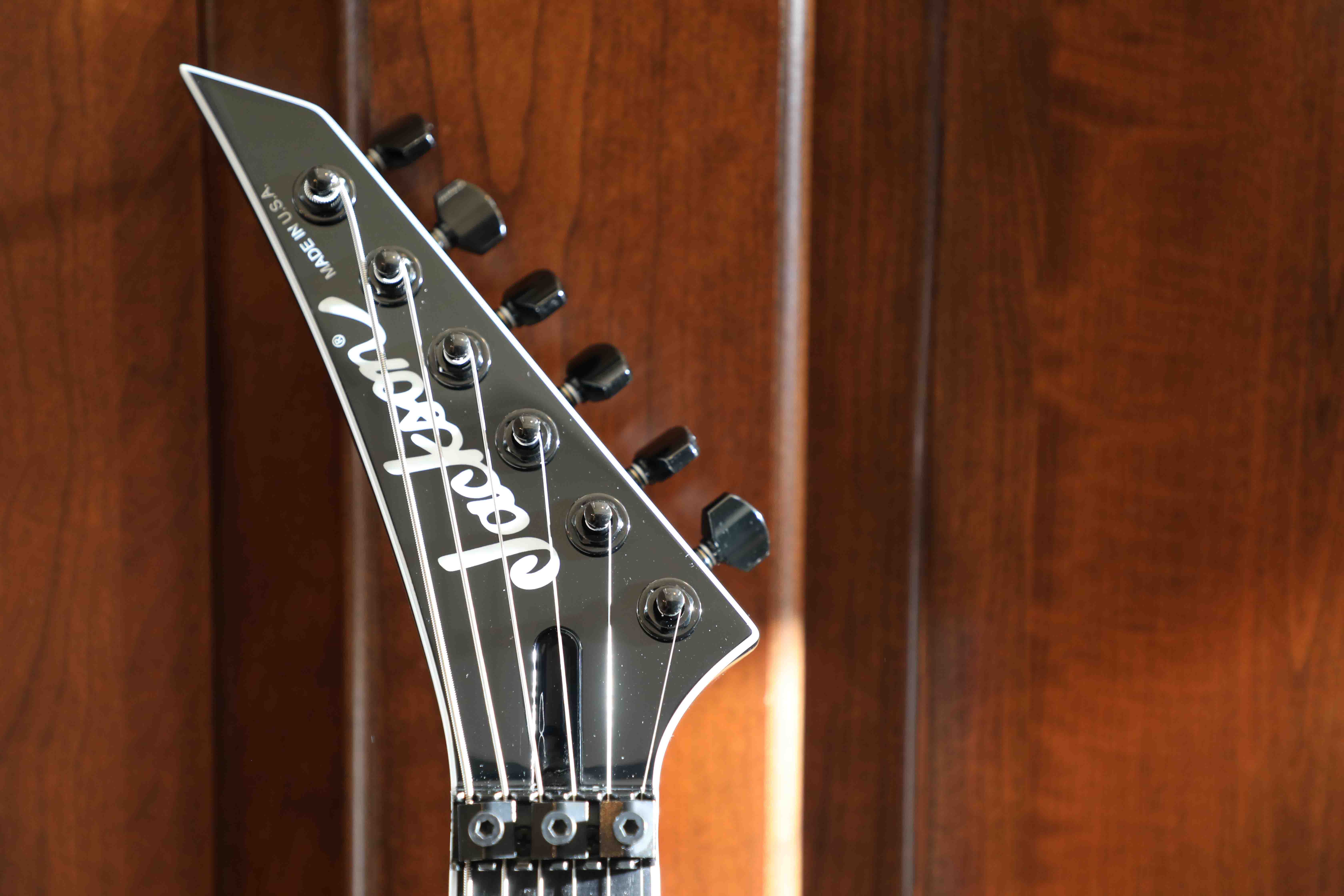
“That’s on my limited-edition signature made by the Jackson shop master builders. It’s the same bridge in all my Jacksons that I play live, but there is a new one we are working on - where you can have a Floyd without knocking a hole in your guitar. More wood means a bigger sound and more sustain.
“These big heavy bolts on each side allow you to adjust the pitch and it expands then fits into the guitar body. The sustain is crazy. Where the normal arm would go, they made a cabin. It’s never been done on a production guitar before… it’s been licensed and is about to come out. It’s the most impressive shit - those guys are so on top of stuff. I would run ideas at them and it would be like, ‘Hold my beer!’ Those engineers are fuckin’ geniuses and we’re so excited about it. I’ve never seen guys work so quickly and professionally...”
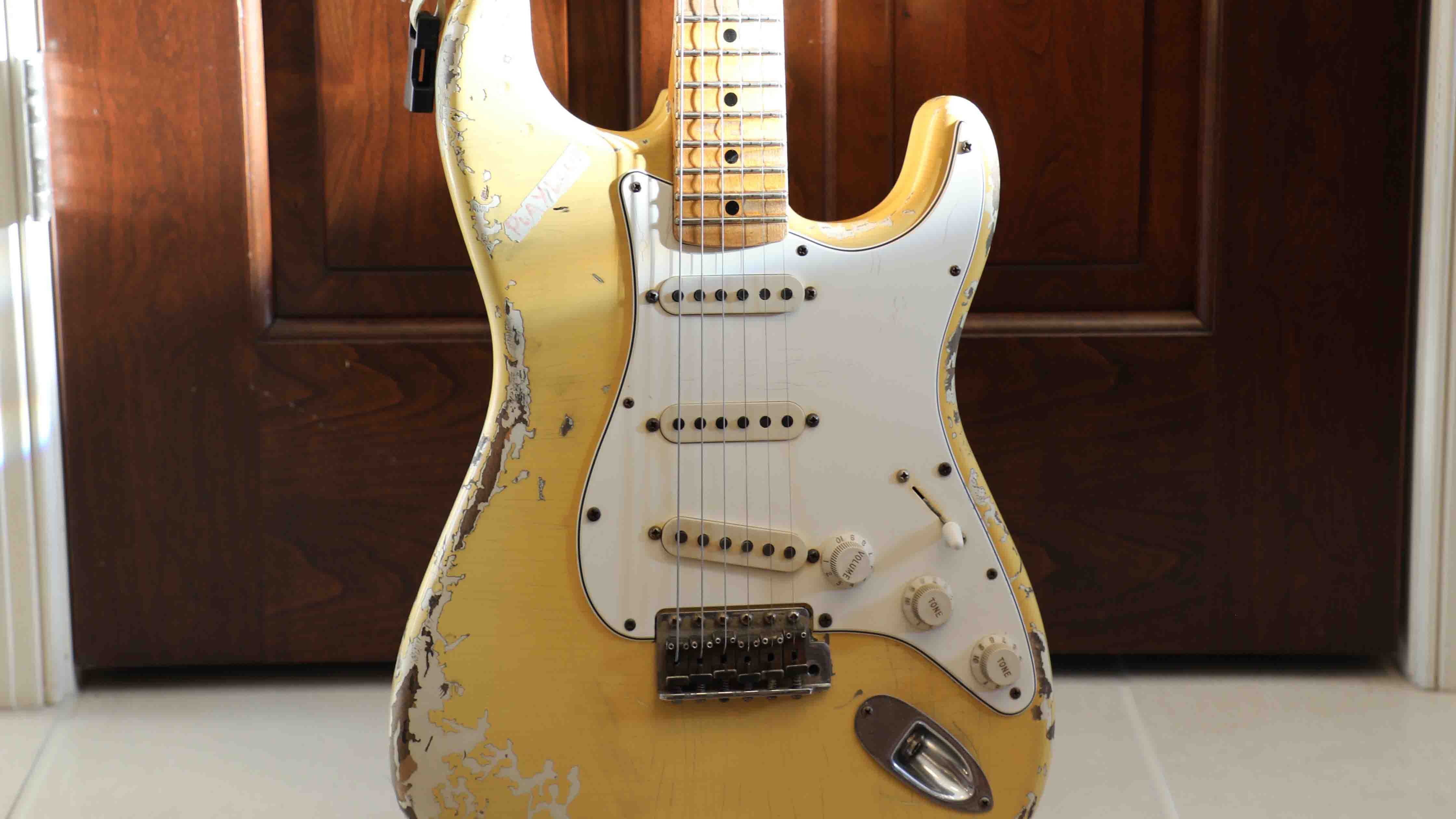
7. Fender Yngwie Malmsteen Stratocaster
“This is part of the tribute run of 100 done by the Fender master builders and is an exact copy of Yngwie's Play Loud Strat.
“I’ve actually been to the Fender Custom Shop… oh my god. They also have the Jackson Custom Shop there, as well as Gretsch. The craftsmanship and meticulousness of what each builder is doing is like nothing I’ve ever seen. Each master builder has their own personal workshop and desk - it’s a fucking operation in there.
“Yngwie is a life-changing kinda guitar player. When I got Rising Force on cassette, it was like, ‘What the fuck did I just hear?’ I had Surfing With The Alien on vinyl when it came out, I was also into Cacophony and Racer X… all those guys are amazing. But Yngwie was a little earlier than them; without that guy I don’t know if the whole Shrapnel records thing might have happened.
“He was so influential in that approach to playing - to think he was using single coils through a dirty channel thatwas so clean, you could hear every note. It wasn’t highly distorted and compressed, he’s really playing that shit… on 8-gauge strings!”
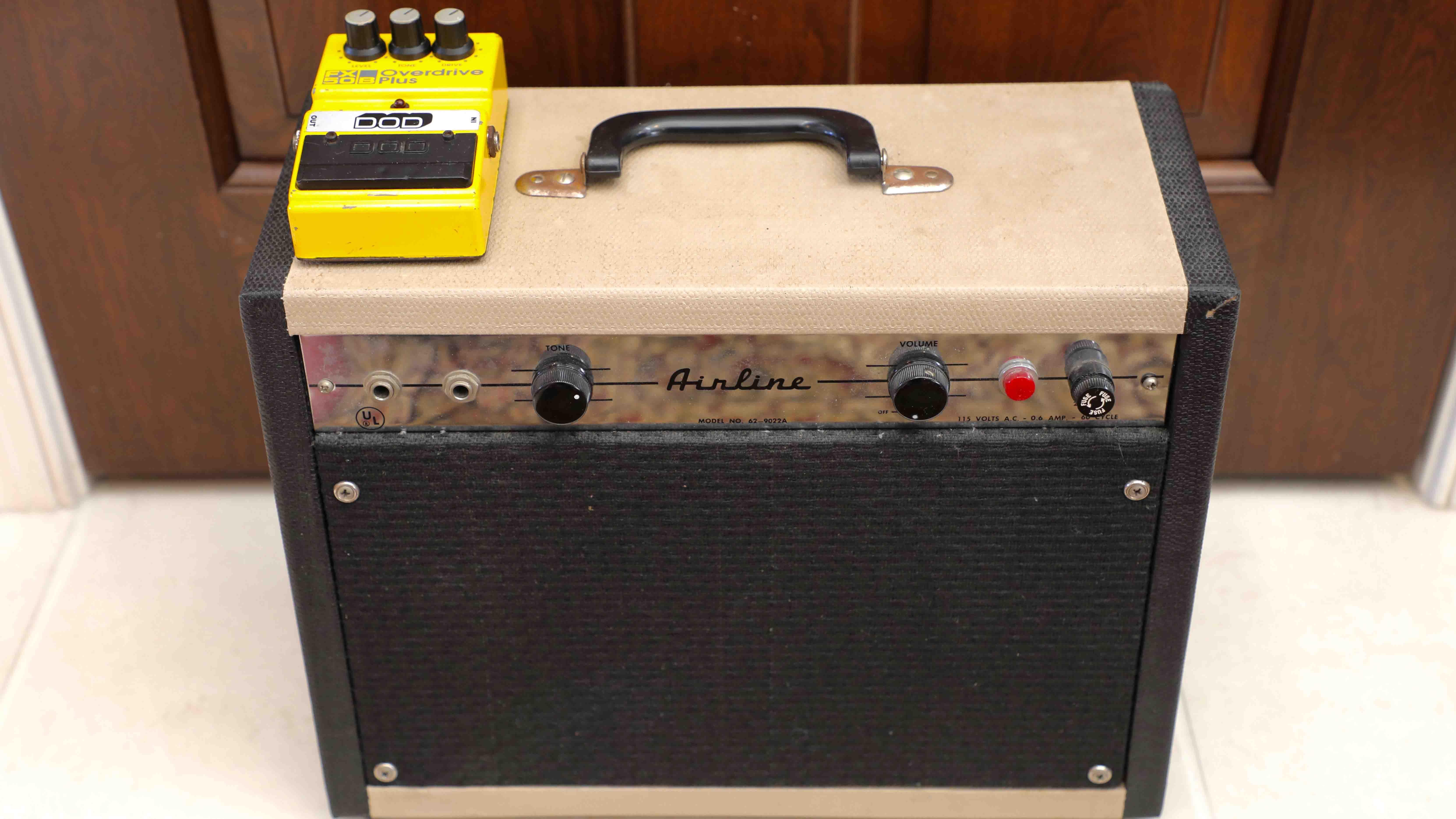
8. Airline Amp & DOD FX50B Overdrive
“This was my first-ever guitar rig.
“It was a 1960s tube amp - sold by Sears, I believe - that I got as a gift from my uncle John, who’d had it since he was a kid. He found out I’d started playing, probably around the age of 10 when I did a paper round to save up enough for my first guitar, which is locked away in some storage unit. It was a little 3/4-sized tobacco sunburst Hohner Tele with one single-coil pickup going through a speaker cable, so it buzzed like a motherfucker!
“It went straight in at first and then after saving 50 bucks I got that overdrive. I sold the amp about 20 years ago just because I thought it was a piece of shit that I didn’t need, which was stupid.
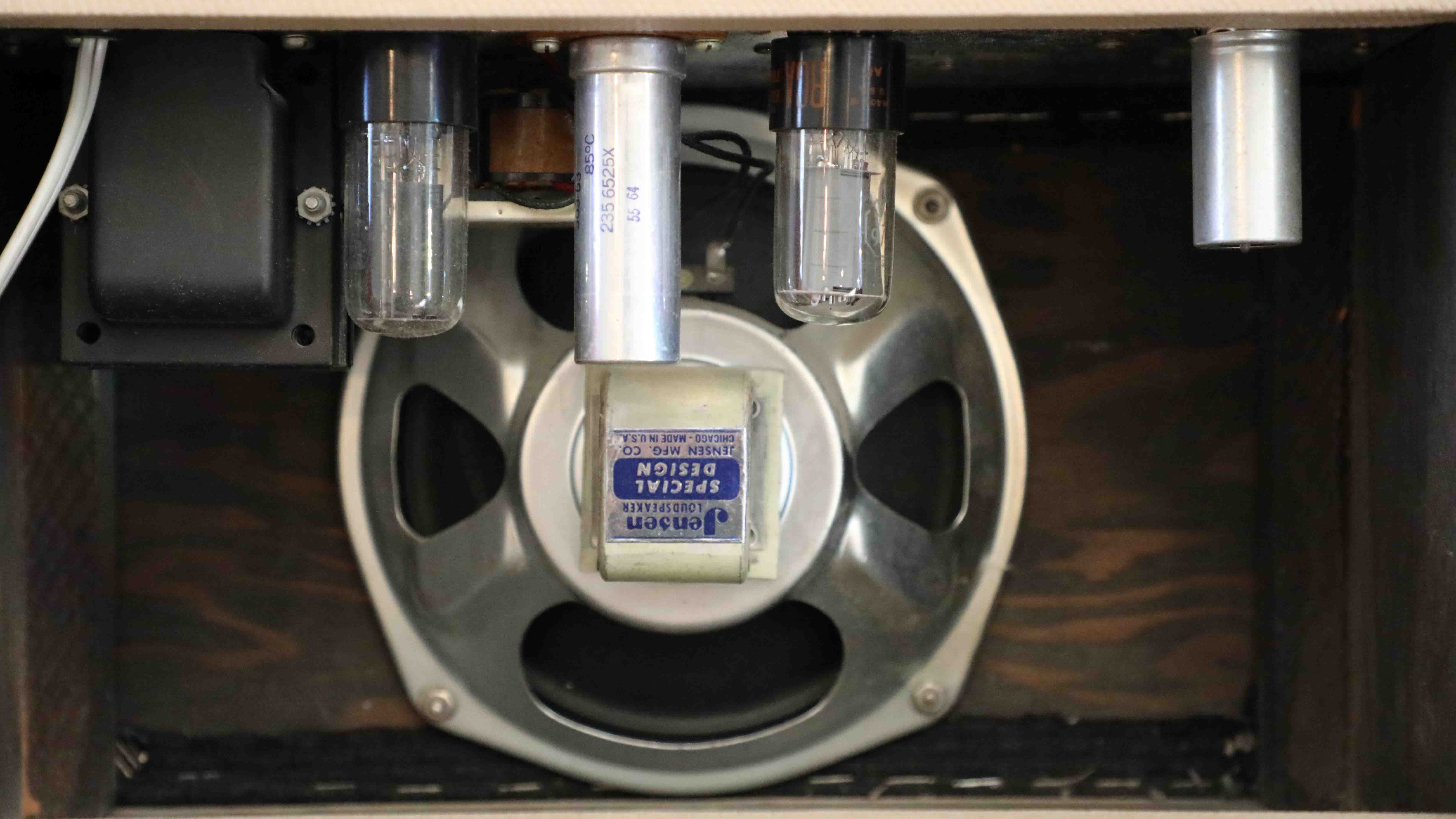
“Eventually I went online, searched and searched until I found one in good condition - because you get older and wish you had your first guitar and amp. So it’s not original, but sometimes you get nostalgic. I’d love to put that on a record, find a space for some noisy shit or gross little line I can play through it.”
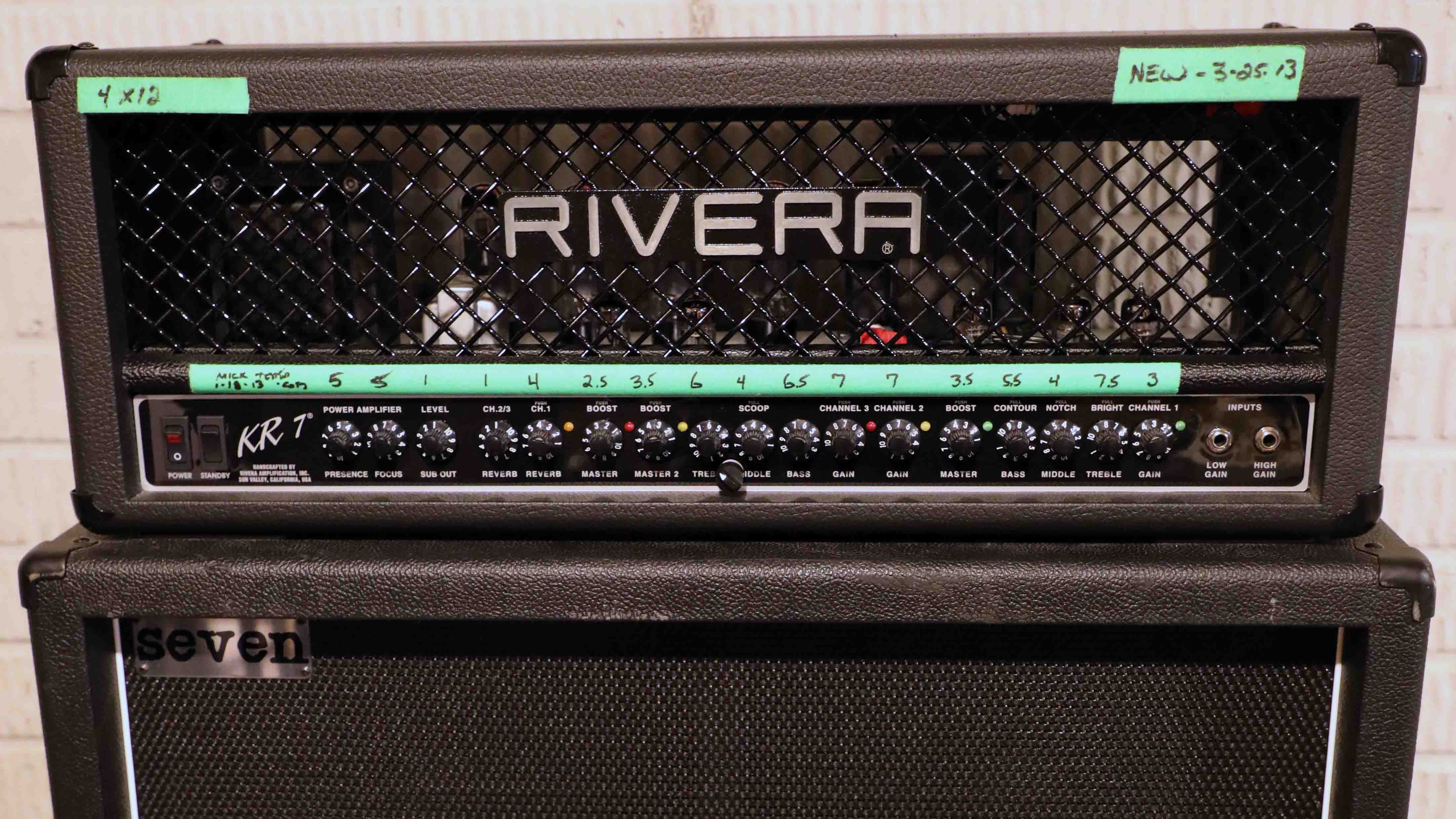
9. Rivera KR7 head & Seven 4X12 cabinet
“These are my signature models, used on the last two albums and all our touring up until early last year.
“The bottom-end extends pretty deep. That shit keeps on going, depending on what speakers you use, you might not even realise just how deep they can go! If you think about watching TV with the speakers that are built-in and then comparing that to an home entertainment system with a sub, where even the commercials shake the entire house - that’s the difference, because your TV speakers just can’t produce those frequencies.
“I plugged this into so many different speakers, it was even surprising for me how much ass it has! I met with Rivera way back before we even got signed. I had the original Knucklehead in the ’90s. Fast forward to meeting the guys at NAMM years later around Vol. 3, we got talking and I realised I should try out their newer stuff - I was using VHTs at the time.
“So I started working with them, tweaking circuitboards going back and forth. Eventually I got out to LA and went into the lab with Paul Sr. to do all the fine-tuning. He was able to show me all the frequencies being represented on a computer, which was a really cool tool to take out the honky sounds and he had the wizardry to go in and change values. It was a cool learning experience to be able to sit there and see him at work.
“What’s funny is there is so much low-end, our sound guy ends up padding my channel. He basically just chops it off because it keeps on going. When you’re in a band with all sorts of bass frequencies coming from drums, percussions and the rest… I don’t really blame him, haha! I don’t know how they got their amps like that, but even the top range extends high! The full bandwidth on them is pretty damn vast.
“On the last record, I used this rig and a virgin Marshall 800 that was untouched from the ’80s, which sat so perfectly in between. The Rivera had the highs and lows, while the 800 brought those beautiful mids… even when scooped! They sat perfectly together for my rhythm tone on the latest album.”
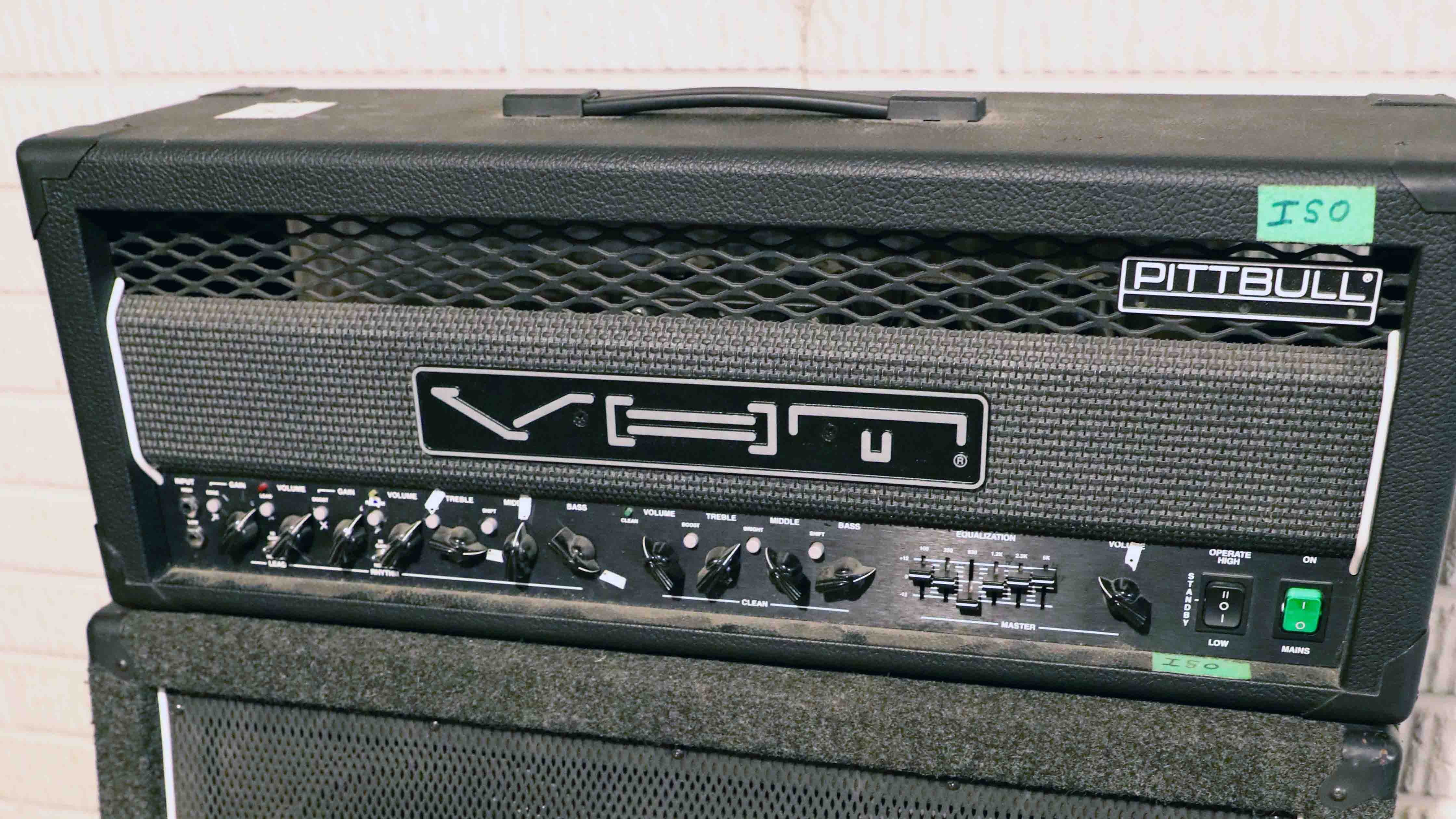
10. VHT Pitbull & Carvin 4x12 cabinet
“This is what I used on Iowa and Vol. 3 - to be honest, pretty much all our touring until then, as I switched to Rivera. I think the Carvin cabinet was even used on our first record and touring around it.
“I remember I always used to see VHTs in magazines, and when we played our first show in London at the Astoria, there was a guitar shop right across the street. I walked over and they had a Pitbull in there… I plugged it in and pretty much shit myself! I couldn’t believe how monstrous it sounded, so when I got back I sent a couple of emails saying, ‘I don’t care what I have to do, but I need to get a couple of these VHTs!’ Honestly, I would have done some rude shit to get my hands on some…
“They sent me a couple and god damn, they were just ridiculously massive. They absolutely roar and I still have them. The picture was taken in my basement, so it probably looks horrible compared to the rest of my stuff - it was hours and hours of work to freshen these guitars up with lemon oil, polish and get them ready for photos!
“Those old grey carpet Carvin cabs are really heavy - they switched to tolex or whatever and started making thinner cabs that didn’t weigh anything. These old ones sound really beefy, with these Eminence-made BR100 speakers that were originally stocked. There’s just something about it!
“When we did our first record, I took my Carvin cab, a Rocktron Piranha into a Boogie 295 power amp. We fed it through every speaker in the room and the Carvin cab sounded the best. Other bands tried plugging into those and it just didn’t work for some reason; I guess it’s partly because I tailored all my EQ for that Carvin.
“I had VHT cabinets but I didn’t like the stock speakers at the time; they were kinda dark. This was my rig for Iowa… which was definitely more raw-sounding than the other records, using my black Warlock with an EMG 81 on the bridge going onto two-inch tape…
“That was actually the last thing we recorded on two-inch tape. My rig was pretty minimal, to be honest. A lot of people use loads of mics and outboard gear; we just went for the raw kinda sound. Vol. 3 was so much of a cleaner recording - I dropped the gain a bit, added more mids… it was our first time using Pro Tools. But it was the exact same amp, just on different settings.”
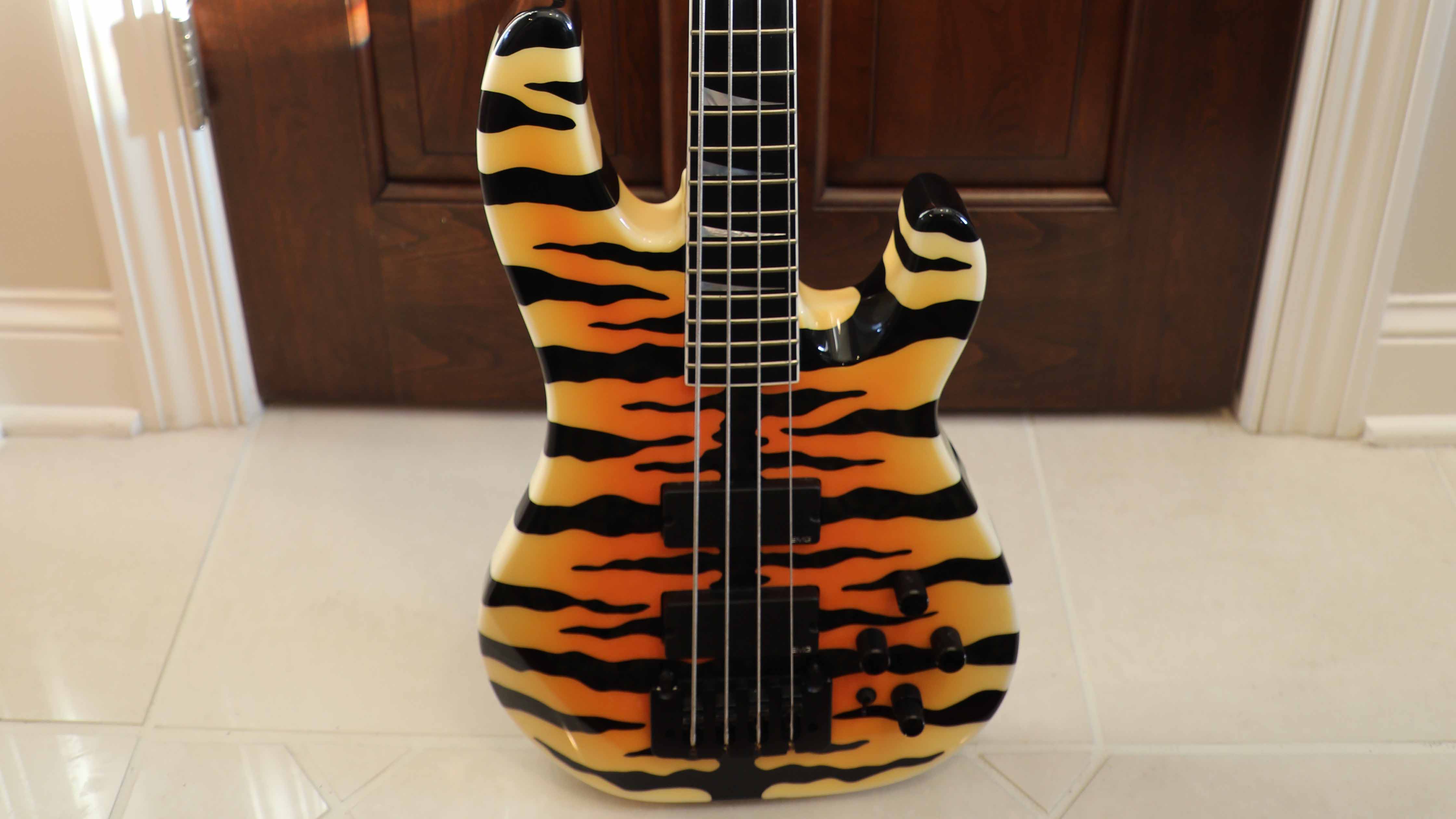
11. Jackson Custom Concert Bass
“In 2005, I knew I had to get this the second I saw it. I mean… it has a fucking whammy bar, haha! It was built for Drum City Guitarland and is fun to play, sounds great and helps with writing riffs that are different. I come up with ideas that are nothing like what I’d do on guitar.
“I’ll probably get shit about this, just like the seven-string because everyone will be like, ‘Oh, I thought you hated seven-strings!’ But I like experimenting with instruments that make you come from a different place mentally… and this bass is great for that.
“Using different tools help you break out of the mould. After a number of years playing, you fall into a certain pattern that’s just you. You become you more and more over time, and it gets hard to strip back and see other things. Writing on bass is such a different approach, plus it’s good for your fingers!
“It’s exercise: you have to stretch more because of the scale length. Simply for the athletics, playing bass is great for guitar players and offer a different perspective musically.”
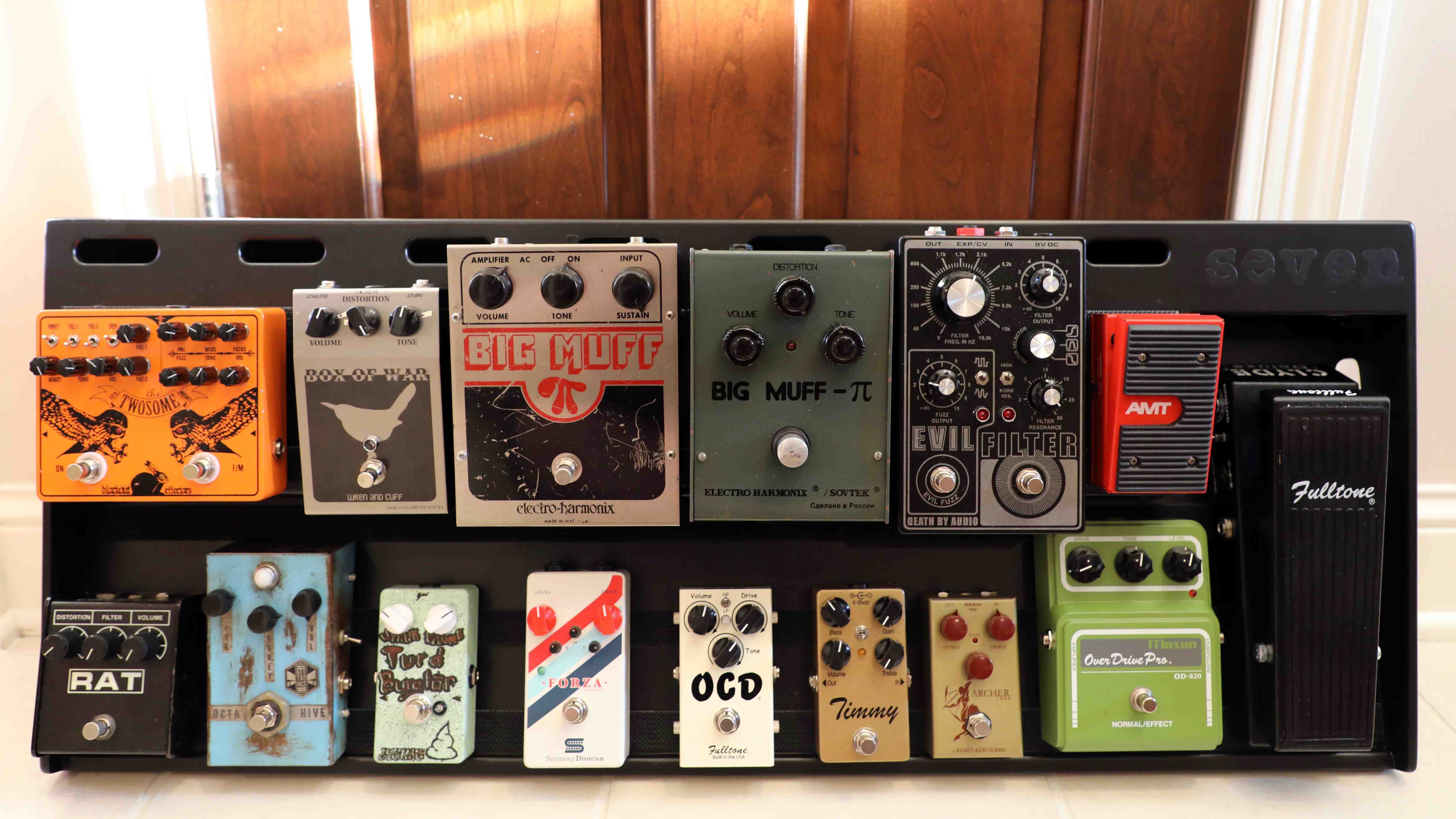
12. Pedalboard
“This is by no means all my pedals; it’s just what’s in the process of being built together. It’s mainly a bunch of different wonderful dirt boxes and I haven’t even wired it up.
“The Big Muff on the left of the Russian model is actually a 1976 model, just like the one Billy Corgan used on Siamese Dream. It had a whole different circuit, using op-amps or some other shit.
“Normally my pedals are strewn all over the kitchen floor, so I decided to get building different 'boards. There’s another I’m working on with some of my other dirt boxes, plus modulations and delays and other neat noise-makers… cool things to fuck up your sound, basically. I’ve got so many other pedals I love that are absolutely worthy of being on this ’board, but there are only so many square inches of space.
I’ll pick up a Strat or Tele when I use certain fuzz pedals, as opposed to crushing them with my signature Seymour Duncan active pickups
“This 'board encompasses a lot of really good shit. The Maximum Overdrive used to go in front of my Marshall 800 for all the rhythm tracking on the latest record. It’s such a clean, perfect overdrive. If you have the gain under 5% it actually kicks the dirt out of the circuit, so it works as a clean boost. It’s quite a magical pedal. There are a million different versions of 808 Tube Screamers, but I just love this thing!”
“The Evil Filter hasn’t been used on any recordings yet, but you plug that thing in and it seems limitless in how many different sounds you can get. Especially when using guitars with single coils or P-90s! Regular humbuckers tend to vary, and a lot of fuzz pedals don’t like active pickups much. You almost want single coils to make it more expressive rather than slamming the signal at all ends, which doesn’t let it speak as well as it can.
“So I’ll pick up a Strat or Tele when I use certain fuzz pedals, as opposed to crushing them with my signature Seymour Duncan active pickups. Kicking in different pedals also helps you come with things you wouldn’t have. Even using fuzz instead of normal distortion will change what you come out with…”
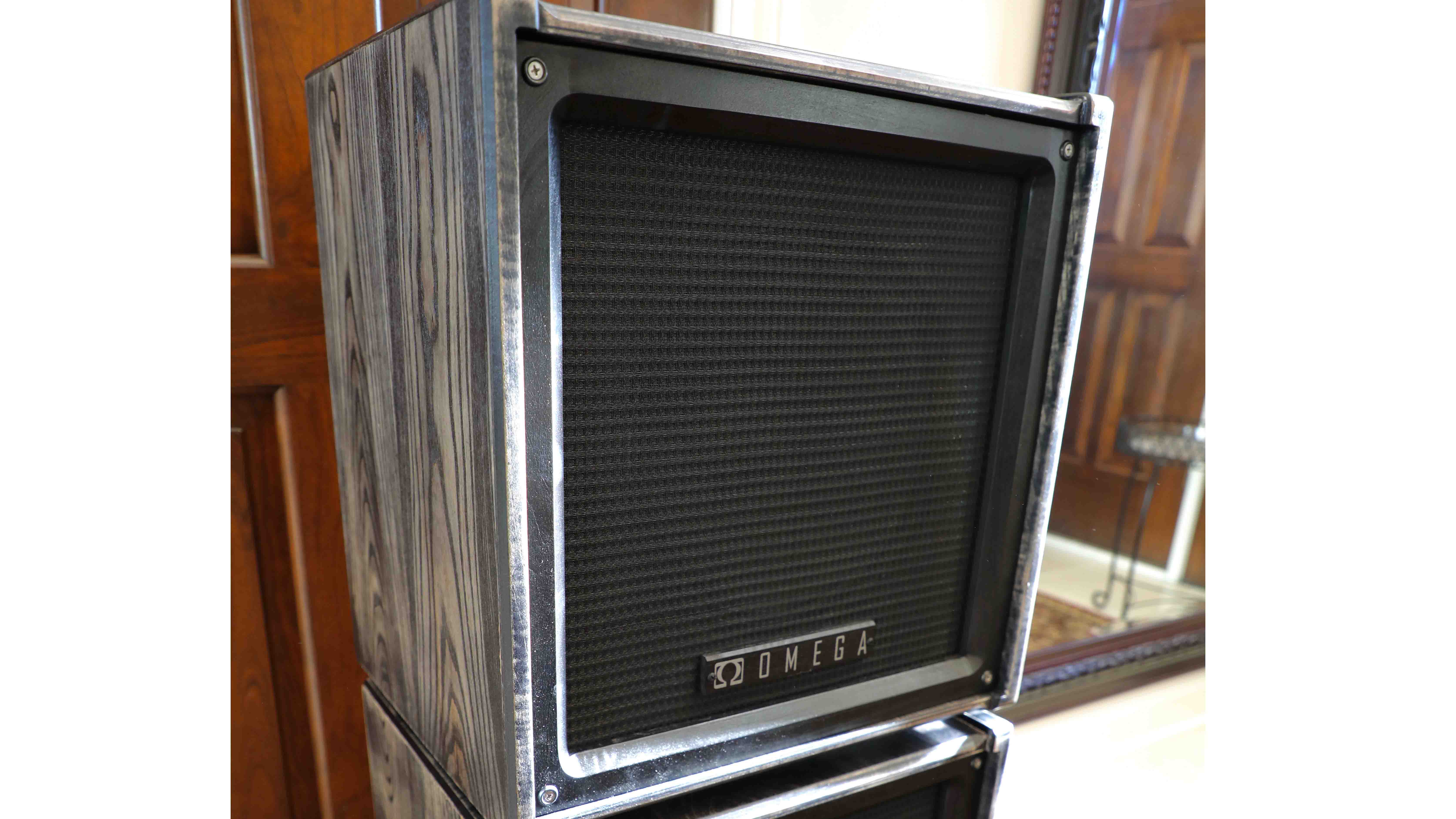
13. Powered By Omega Cabinets
“The cabinets are handmade and unlike anything else I’ve ever seen, from the reinforcement and design. The entire approach is different.
“Why are all Ampegs a certain size? Well, it’s because it will fit certain cabinets… we tend to repeat ourselves. Think about how many guitar bodies could potentially exist, but what’s the number one thing that’s been around? The Strat! Anything outside of Les Pauls or Strats or V’s - which are still pretty oddball - there’s only a few guitar designs, and it’s the same for speaker cabinet makers.
“In fact, a lot of things are made by the same guy in the same factory and they’ll just slap a different badge on it and call it whatever! These are hand-oiled, not sealed and glued. They use tone wood - ash sides, I forget what the top is… all these different woods based on what tonal properties you want. It’s almost like building a guitar. I honest didn’t think guitar cabinets could sound this good. Speakers that sounded average take a whole new life in this!

“I can’t wait to get in the studio again, because these will sound amazing mic’d up. They currently have a Boogie and a Celestion inside. I’m sure I’ll blend it with a 4x12 just for size, but honestly, if you weren’t looking, you would not know this was two 1x12 cabinets… you would think it was a 4x12 from the bass resonance and musicality.
“The cabinet is so often the afterthought. You spend all your money on your amp and then throw any old cabinet next to it. The nuances within this is like some whole fucking voodoo thing, it’s crazy. I have tons and tons of amps, but I don’t really have many cabinets. This is incredible.
“Mike, the owner, understands what wood would work best for the sounds I try to describe… it just works! Sometimes I’ll put a little Mark V 25, one of the tiny things, which absolutely roars, but then I might run a Diezel Herbert through it. I’ve thrown all sorts at it and everything sounds great. It reveals more about the amp.
“This is something to think about - I don’t know many cabinet purists out there. It’s not a sexy thing - a brand-new guitar is a sexy thing, not a speaker cabinet… but it’s definitely worth looking more into this stuff.”
Amit has been writing for titles like Total Guitar, MusicRadar and Guitar World for over a decade and counts Richie Kotzen, Guthrie Govan and Jeff Beck among his primary influences. He's interviewed everyone from Ozzy Osbourne and Lemmy to Slash and Jimmy Page, and once even traded solos with a member of Slayer on a track released internationally. As a session guitarist, he's played alongside members of Judas Priest and Uriah Heep in London ensemble Metalworks, as well as handling lead guitars for legends like Glen Matlock (Sex Pistols, The Faces) and Stu Hamm (Steve Vai, Joe Satriani, G3).

